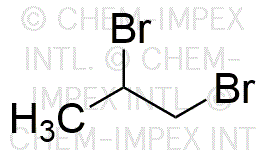1,2-Dibromopropane is widely utilized in research focused on:
- Organic Synthesis: This compound serves as a versatile intermediate in the synthesis of various organic molecules, making it valuable for chemists developing new pharmaceuticals and agrochemicals.
- Solvent Applications: It is used as a solvent in chemical reactions and extractions, particularly in laboratories where non-polar solvents are required for specific reactions.
- Chiral Synthesis: 1,2-Dibromopropane can be employed in the preparation of chiral compounds, which are essential in the production of many drugs, enhancing the efficacy and safety of medications.
- Polymer Production: The compound is utilized in the synthesis of certain polymers, contributing to the development of materials with unique properties for use in packaging and coatings.
- Research in Environmental Chemistry: It is also studied for its environmental impact and behavior, aiding researchers in understanding the degradation processes of brominated compounds in ecosystems.
Información general
Propiedades
Seguridad y normativas
Aplicaciones
1,2-Dibromopropane is widely utilized in research focused on:
- Organic Synthesis: This compound serves as a versatile intermediate in the synthesis of various organic molecules, making it valuable for chemists developing new pharmaceuticals and agrochemicals.
- Solvent Applications: It is used as a solvent in chemical reactions and extractions, particularly in laboratories where non-polar solvents are required for specific reactions.
- Chiral Synthesis: 1,2-Dibromopropane can be employed in the preparation of chiral compounds, which are essential in the production of many drugs, enhancing the efficacy and safety of medications.
- Polymer Production: The compound is utilized in the synthesis of certain polymers, contributing to the development of materials with unique properties for use in packaging and coatings.
- Research in Environmental Chemistry: It is also studied for its environmental impact and behavior, aiding researchers in understanding the degradation processes of brominated compounds in ecosystems.
Documentos
Hojas de datos de seguridad (HDS)
La SDS proporciona información de seguridad completa sobre la manipulación, el almacenamiento y la eliminación del producto.
Especificación del producto (PS)
La PS proporciona un desglose completo de las propiedades del producto, incluida la composición química, el estado físico, la pureza y los requisitos de almacenamiento. También detalla los rangos de calidad aceptables y las aplicaciones previstas del producto.
Certificados de análisis (COA)
Busque certificados de análisis (COA) ingresando el número de lote del producto. Los números de lote y de partida se pueden encontrar en la etiqueta de un producto después de las palabras "Lote" o "Lote".
Número de catálogo
Número de lote/lote
Certificados de origen (COO)
Este certificado de origen confirma el país en el que se fabricó el producto y también detalla los materiales y componentes utilizados en él y si se deriva de fuentes naturales, sintéticas u otras fuentes específicas. Este certificado puede ser necesario para cumplir con las normativas aduaneras, comerciales y regulatorias.
Número de catálogo
Número de lote/lote
Hojas de datos de seguridad (HDS)
La SDS proporciona información de seguridad completa sobre la manipulación, el almacenamiento y la eliminación del producto.
DownloadEspecificación del producto (PS)
La PS proporciona un desglose completo de las propiedades del producto, incluida la composición química, el estado físico, la pureza y los requisitos de almacenamiento. También detalla los rangos de calidad aceptables y las aplicaciones previstas del producto.
DownloadCertificados de análisis (COA)
Busque certificados de análisis (COA) ingresando el número de lote del producto. Los números de lote y de partida se pueden encontrar en la etiqueta de un producto después de las palabras "Lote" o "Lote".
Número de catálogo
Número de lote/lote
Certificados de origen (COO)
Este certificado de origen confirma el país en el que se fabricó el producto y también detalla los materiales y componentes utilizados en él y si se deriva de fuentes naturales, sintéticas u otras fuentes específicas. Este certificado puede ser necesario para cumplir con las normativas aduaneras, comerciales y regulatorias.


